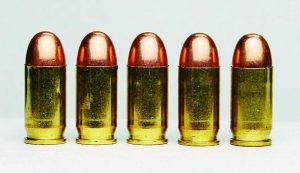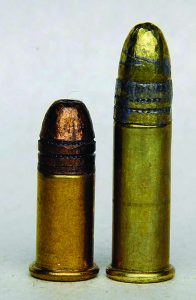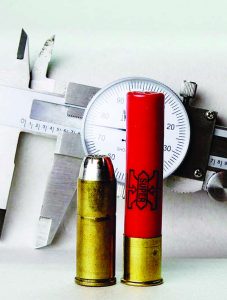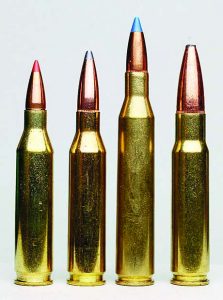by Art Merrill | Contributing Editor

9mm Court, 9mm Kurz, 9mm Browning, 9x17mm, .380 ACP (L-R or R-L, take your pick).
Summertime is camping time for most of America. Camping means sleeping on rocks, eating burnt food, shooting .22s and sitting around the campfire. That latter practice entails inevitable discussions of guns and the tossing about of related factoids. When you decide to get away from your loading bench for a bit of camping, here’s some fun cartridge and firearms related trivia with which to impress your fellow campfire sitters.
***
What is the oldest cartridge still in production?
Introduced by Horace Smith and Daniel Wesson in 1856, .the .22 Short turned 161 years old in 2017. It is the world’s first commercially successful self-contained cartridge.
***

Though eclipsed in popularity by the .22 Long Rifle, the .22 Short that started it all turns 161 this year.
Which bullet has the highest sectional density (SD)?
- .308 200-gr. lead round nose
- 6.5mm 140-gr. HP
- 8mm 196-gr. FMJ
- .308 200-gr. solid copper spitzer
Scratching this formula in the dirt by the light of the campfire a la Archimedes:
Bullet weight in grains
7000 x (bullet diameter) 2
gives us sectional density; of the listed bullets, the .308s have SDs of .301, the 8mm (.323” diameter) SD is .273, and SD of the .264” 6.5mm bullet is .409. The smaller, lighter 6.5mm has the highest SD. Regarding those .308s, bullet shape or material has no effect on sectional density; bullets of the same caliber and weight have the same SD. Given a solid, nonexpanding bullet, SD is directly related to a bullet’s penetration; deep penetration is why those famous African hunters raved about the early 6.5mms being such great elephant killers with brain shots.
***
What do these cartridges have in common with the .380 ACP?
9mm Court
9mm Kurz
9mm Browning
9x17mm
They are all the same cartridge, known by different names – we call it the 380 ACP. Walk into your local gun shop, ask for a box of 9mm Kurz, and see what happens.
***

Because outside dimensions differ by only about .003”, the .45 Colt and .410 shotshell can share long-enough chambers.
Winchester introduced the .20 Wingo Rimfire in the early 1970s. What on earth for?
Winchester created the .20 Wingo Rimfire shotshell for an urban indoor competition wherein small, hollow ice balls replaced the clay pigeons of trap & skeet. The cartridge rim and head were the same as the .22 rimfires, but the case body was only .200”, making it impossible to chamber a .22 rimfire in the smoothbore firearm. The Wingo concept, obviously, flopped. Is it time to bring it back?
***
While on that subject, what is the smallest shot shell still in production? We’re excluding here cartridges for rifled arms and considering only those intended for specific smoothbore shotguns.
Does .355” sound familiar? That’s the bullet diameter of the 9mm Luger and the bore diameter of the 9mm Rimfire and 9mm Flobert shotguns. Though not popular here in the US, Europeans have been using 9mm “garden guns” on pests and to put urban squab (pigeon) on the table for many years. The Flobert throws a 1/4 oz charge of shot at about 1,000fps, the 9mm Rimfire about 1/3oz of shot at 600fps. Fiocchi loads the Flobert cartridge, which is available from major US catalog retailers Midway USA and Cheaper Than Dirt. If you decide to campaign for the revival of Wingo, at least this cartridge is still around.
***
Ignoring shotgun choke constrictions, what “caliber” is a 12ga shotgun? What “caliber” is a .410 shotgun?
Minimum bore diameter of the 12 gauge shotgun is 0.716”, so the 12ga is roughly a .71 caliber. The .410 bore minimum is .401”, making it a .40 caliber. Some .45 Colt handguns with lengthened chambers will accept .410 shotshells because the .410 shot shell has an outside diameter close to that of the .45 Colt. The .410 shot shell’s bore fit to the .45 Colt is not ideal, but it works. Somewhat. To conform to federal law, these handguns must have rifling in order to not be considered illegal short-barreled shotguns; the rifling, of course, imparts spin to the shot wad, which tends to throw shot outward from center, making accuracy and usefulness nonexistent beyond a few yards.
***
And that leads us to ask, where does shotgun “gauge” come from?
“Gauge” is from the early days of English canon and refers to how many lead balls of a specific diameter would equal one pound. A 12 gauge shotgun would need 12 lead balls of .716” diameter to make a pound. Sometimes the word “bore” substitutes for “gauge,” as with the old British muzzleloading 4-bore double elephant gun, which threw quarter-pounders (one pound or 16oz ÷ 4 = 4oz, or ¼ pound) from the shoulder. If that kind of recoil sounds a bit brutal, in A Hunter’s Wanderings in Africa ivory hunter Frederick Selous relates an incident in which he fired a 4-bore his rifle bearer unintentionally double loaded with a second charge and ball atop the first one. What happened to the elephant? Nothing. What happened to Fred? Oi…
***

The 243, 260 Remington, 25-06 and 338 Federal – one of these things is not like the others.
Which of the following cartridges is unrelated to the other three?
- 243 Winchester
- 260 Remington
- 25-06 Remington
- 338 Federal
- The parent case for the 243 Win, 260 Rem and 338 Federal is the .308 Winchester. The 25-06’s parent case is the .30-06. Perhaps the question is somewhat disingenuous because, of course, the .308 Win is itself based on the .30-06. Of such are arguments born.
***
Speaking of which, here’s a good campfire argument: Is a revolver a pistol?
A bit tricky, there are several possible correct answers. In the days of one-shot flintlock and percussion arms, all handguns were called pistols. And then as early as 1846, Samuel Colt referred to his newfangled revolvers as, “repeating pistols.” There you have it, The Man says a revolver is a pistol.
But language changes over time with common mis-usage and new developments. The invention of the semiautomatic pistol has led firearms historians like W.H.B. Smith to redefine “pistol” thusly: “Pistol. 1. A firearm designed to be fired using one hand only, and having a chamber integral with, or permanently aligned with, the bore. 2. Popularly, but improperly, used to designate any weapon designed to be fired using only one hand; i.e., both pistols and revolvers.”
Did Smith base his definition on some previous argument or historical common usage, or did he simply give himself the authority to streamline our firearms lexicon? Regardless, others have picked up on his definition and there you have it: a revolver is not a pistol.
Now let’s argue about “magazines” vs “clips.”
On second thought, let’s not. The fire is dying to coals, the coyotes and crickets have taken over the night shift and we’ve drunk our ration of chosen beverage. Time to sack out and stare at the stars and satellites and look forward to a burnt Spam breakfast and another day of plinking. Tomorrow I’ll sneak some handloaded shot shells into my pistol/revolver/handgun and wow you by shooting tossed bottle caps out of the air until you figure it out…



